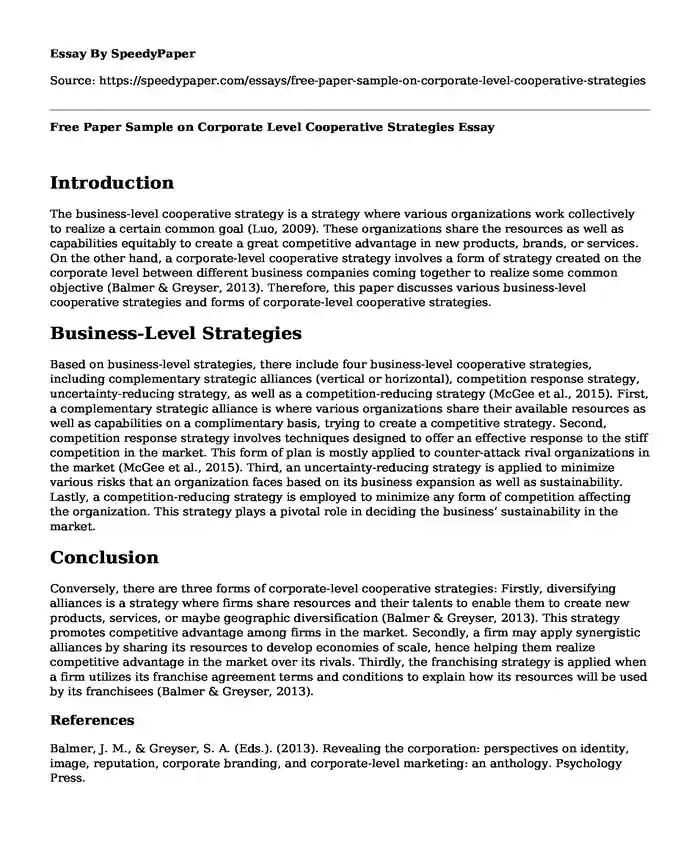
| Type of paper: | Essay |
| Categories: | Strategic management Business management |
| Pages: | 2 |
| Wordcount: | 415 words |
Introduction
The business-level cooperative strategy is a strategy where various organizations work collectively to realize a certain common goal (Luo, 2009). These organizations share the resources as well as capabilities equitably to create a great competitive advantage in new products, brands, or services. On the other hand, a corporate-level cooperative strategy involves a form of strategy created on the corporate level between different business companies coming together to realize some common objective (Balmer & Greyser, 2013). Therefore, this paper discusses various business-level cooperative strategies and forms of corporate-level cooperative strategies.
Business-Level Strategies
Based on business-level strategies, there include four business-level cooperative strategies, including complementary strategic alliances (vertical or horizontal), competition response strategy, uncertainty-reducing strategy, as well as a competition-reducing strategy (McGee et al., 2015). First, a complementary strategic alliance is where various organizations share their available resources as well as capabilities on a complimentary basis, trying to create a competitive strategy. Second, competition response strategy involves techniques designed to offer an effective response to the stiff competition in the market. This form of plan is mostly applied to counter-attack rival organizations in the market (McGee et al., 2015). Third, an uncertainty-reducing strategy is applied to minimize various risks that an organization faces based on its business expansion as well as sustainability. Lastly, a competition-reducing strategy is employed to minimize any form of competition affecting the organization. This strategy plays a pivotal role in deciding the business’ sustainability in the market.
Conclusion
Conversely, there are three forms of corporate-level cooperative strategies: Firstly, diversifying alliances is a strategy where firms share resources and their talents to enable them to create new products, services, or maybe geographic diversification (Balmer & Greyser, 2013). This strategy promotes competitive advantage among firms in the market. Secondly, a firm may apply synergistic alliances by sharing its resources to develop economies of scale, hence helping them realize competitive advantage in the market over its rivals. Thirdly, the franchising strategy is applied when a firm utilizes its franchise agreement terms and conditions to explain how its resources will be used by its franchisees (Balmer & Greyser, 2013).
References
Balmer, J. M., & Greyser, S. A. (Eds.). (2013). Revealing the corporation: perspectives on identity, image, reputation, corporate branding, and corporate-level marketing: an anthology. Psychology Press.
Luo, Y. (2009). Entry and cooperative strategies in international business expansion. Greenwood Publishing Group.
McGee, J. E., Dowling, M. J., & Megginson, W. L. (2015). Cooperative strategy and new venture performance: The role of business strategy and management experience. Strategic management journal, 16(7), 565-580.
Cite this page
Free Paper Sample on Corporate Level Cooperative Strategies. (2023, Nov 25). Retrieved from https://speedypaper.com/essays/free-paper-sample-on-corporate-level-cooperative-strategies
Request Removal
If you are the original author of this essay and no longer wish to have it published on the SpeedyPaper website, please click below to request its removal:
- Essay Sample on the Reasons for the High Cost of Driving a New Car in the United States
- Role of Relationship Marketing In Competitive Marketing Strategy
- Essay Sample on Coca-Cola and Oligopoly
- Paper Example on Scottish Airlines Branding Plan
- Free Essay. Strong Brand Awareness
- Corporate Social Responsibility in an Organization's Strategy - Paper Sample
- Ethics: Exploring Decision-Making Frameworks for Meaningful Lives - Paper Example
Popular categories




